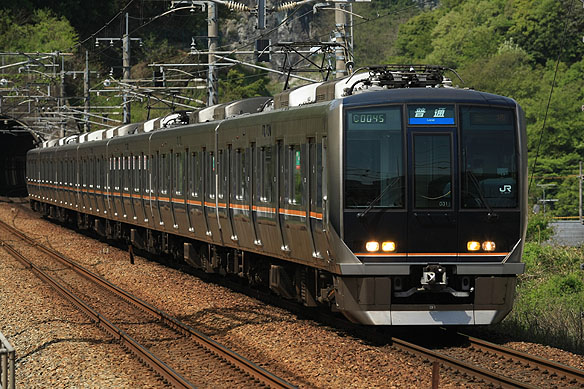The 321 series trains represented the second generation commuter train developed by JR West for use on the local services in Kansai region. 321 series were delivered in order to displace superannuated commuter trains. Compared to 207 series earlier built by JR West, they offer 0.5M system in order to secure the redundancy and flexible train formation.
All vehicles except trailers are equipped with all functions in order to travel, such as a motored bogie, a trailer bogie, a traction system, an auxiliary power supply, etc. The traction system adopting 2-step control on truck basis, in order to realize 0.5M system, differs from that of 223-2000 series adopting 3-step control on axle basis. All motored vehicles are equipped with the auxiliary power supply, since the traction system is unified with the auxiliary power supply. All auxiliary power supplies adopt parallel units operation. Traction motors rated at 270 kW are PG (Pulse Generator) sensor-less induction motors. The acceleration performance is reduced to 2.5km/h/s from 2.7km/h/s of 207 series, because the traction gear ratio is changed into 6.53 that is same as that of 223 series. Although the maximum speed is now 120km/h, 130km/h operation is available in the future. The first production 9 unit had a cross-arm type current collector a vehicle, but this was further increased to two on later units for use on JR-Tozai underground Line. The current collectors of first production unit were also increased to two. Bogies, WDT63/WTR246 based on those of 223-2000 series, adopt the bolster-less air suspension, and their journal box supporting system is axle arm type. The top level of their bolster suspension is lowered than 223-2000 series in order to lower the floor.
The vehicle design incorporates stain-less steel adopting laser beam welding. Their cross section profile is changed from that of 207 series in order to unify the cross section profile between the commuter trains and the suburban trains. 207 series are equipped with semi-automatic side doors, in consideration of use in the Kosei line. Passengers can open or close doors manually by pushing buttons such as 207 series. Four side windows are able to open in order to ventilation in case of emergency. Pass-through doors are located at the centre of the body, differ from 207 series. Passenger information device is changed into 6 LCD color displays. This display does not only indicate the next stop, but the video commercial message.
321 series entered service in 2005 and displaced with 201 series previously used on the local service of JR Kyoto and JR Kobe Lines.
|
|

